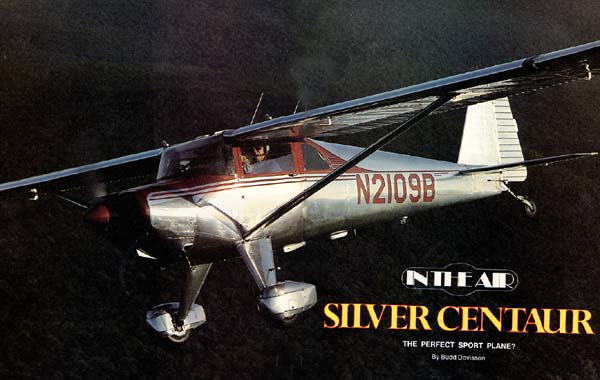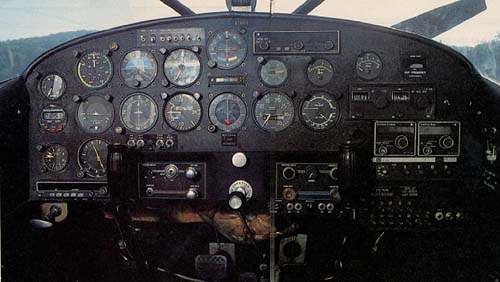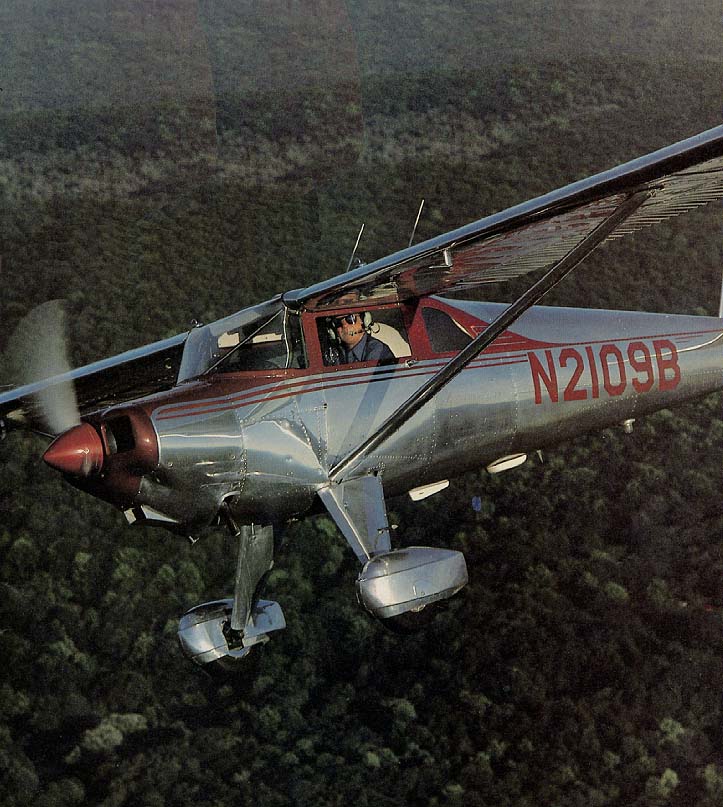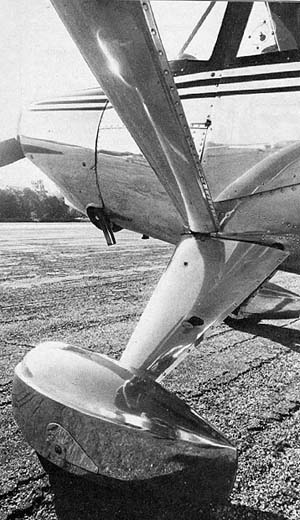

Back in 1937 there seemed to be some unwritten rule that sheet metal was something used only for bombers, fighters and those Lear Jet ancestors such as Spartan Executives that used Pratt & Whitney's in the nose. It was almost never used in little airplanes . . . well, almost never, anyway. There was this Don Luscombe fellow that insisted on building those marvelous little two-place high-wing machines that borrowed heavily on the mystique and the materials of the big boys.
The first metal midget to bear the Luscombe name was the almost-extinct, but still-legendary, Phantom which had lines and a round engine which made it look like a Lockheed Vega that had been run through the fast-dry cycle and shrunk two sizes. Not too many folks know about the Phantom today but Luscombe's second design, the lovely little 8 Series, always comes up when the conversation turns to airplanes that are fast for their horsepower, fun-to-fly and relatively cheap.
The Luscombe 8 started life in 1937 and was still being built under various names as late as the 1950s. The production version started out as 8's with a fifty hp Continental then the better known 8As with sixty-five horse coffee grinders. The Luscombes worked their way up, letter by letter, to the 8F, with the ninety-horse Continental and optional flaps-which brings up an interesting question---if the 8F was the last model of big-engine Luscombe, does that make Gene Popma's airplane a G model?
 Gene Popma of Somerset,
New Jersey, owns one of the "other" types of Luscombes.
You see, as time went on, and thousands of Luscombes were built,
they became one of the most common used airplanes in existence.
Eventually, the time came when an airport of the grassroots variety
wasn't worthy of the name if it didn't have at least one derelict
Luscombe (tires flat, leaning to one side, four families of mice
living in the wings), and two airworthy examples that, if they
were painted at all, were done with a combination of paint rollers
and spray cans. And then there's the "other" type of
Luscombes . . . the dressed-to-kill super birds.
Gene Popma of Somerset,
New Jersey, owns one of the "other" types of Luscombes.
You see, as time went on, and thousands of Luscombes were built,
they became one of the most common used airplanes in existence.
Eventually, the time came when an airport of the grassroots variety
wasn't worthy of the name if it didn't have at least one derelict
Luscombe (tires flat, leaning to one side, four families of mice
living in the wings), and two airworthy examples that, if they
were painted at all, were done with a combination of paint rollers
and spray cans. And then there's the "other" type of
Luscombes . . . the dressed-to-kill super birds.
Luscombes didn't make the jump into the classic category quite as quickly as others in its peer group, like the sophisticated Swift or overtly practical Cessna 140 so, today, the dichotomy between the grassroots, around-the-patch king-of-the-el-cheapo-flying-machines, and the super-spiffy Naugahyde specials is striking. Surely Gene Popma's hot-rodded 8F custom category classic has to be leading the way in dragging more and more of the paint roller specials over to the side of the paint, pamper and polish fanatics.
I'm certain Popma doesn't consider himself to be a fanatic. On the other hand, he's a highly-intelligent, rational business executive who owns two 150 horsepower Luscombes, so he might just be perfectly willing to label himself "fanatic" and be damn proud of it.
Gene and I met as flying fanatics usually do . . . on a sunny day at an airport. Mother 'Nature had gotten her calendar screwed up and mistakenly gave us a Labor Day weekend with weather right out of a Kodak ad. I had both hands on the tail-wires of my Pitts and had just pushed it out through the open hangar doors when this winged block of chrome greased onto the runway and rolled up to the gas pumps. I could see my own reflection from halfway across the ramp, as I walked towards it in the natural gait of a midwestern moth who was attracted to an eastern flame.
By the time I got over to the airplane the pilot and passenger had disappeared into the terminal, so I did several quick laps of the craft and made a beeline after them. There is undoubtedly a type of protocol to be used in rousting somebody out of a rest room but in this case a simple, "Hey-who owns that polished Luscombe?" was enough to bring Gene Popma out the door and headed in my direction. It would have been terribly disappointing had Gene been one of those I've-got-mine-you-find-yours type of individuals. Fortunately, Gene was as enthusiastic about showing his airplane as I was in looking.

Since I had already done a quick turn around the hyper-polished sheet metal, I headed for the interior and found that the sheet metal was outshone by the unexpectedly sophisticated accoutrements of the interior . . . how many Luscombes do you find with new Collins Microline gear and a full IFR panel including ADF? It was so unexpected, in fact, that it took me a second to assimilate everything that was on the panel, because there was so much there that shouldn't have been.
Gene was pleased as a proud papa, as he took me on a tour of the tiny cabin of his traveling machine. He peeled back the Velcroed bulkhead to show the extended baggage tube that carries his golf clubs and pointed out how the rear baggage area would accommodate either a twenty-gallon aux tank (which brings the total up to a whopping forty-five gallons) or a jump seat capable of carrying as much as 180 pounds.
As he would point out different parts of the interior, he would mention that "This was done after the engine conversion" and he mentioned the words "engine conversion" several times before I asked him what the conversion was. He nonchalantly (but with a sly grin) said, "They installed a 150-horse Lycoming."
A 150 Lycoming! I had walked around the airplane several times and been as attentive as you could possibly be while protecting yourself from the awesome glare the airplane presented and I had seen absolutely nothing that indicated this machine was as much "go" as "show". Even after ducking back out and looking at the cowl for a second time, it is hard to pick out any obvious change in form that would set this particular Luscombe nose apart from any others but a 150 Lycoming very definitely sets it apart, whether it shows or not.
It's quite obvious that Gene is used to a certain amount of adulation over his shiny plaything. It's also obvious that he enjoys every second of showing it to appreciative audiences and I was one very appreciative audience.
Gene, an ex-World War Two SBD pilot, first found his Luscombe in 1980 at an airport in Colorado. The airplane had already been converted to a 150, but in many other ways did not measure up to what Gene's idea of a custom classic should be, so he took it back up to Moody Larson in Belleville, Michigan, who did the original conversion and bad him strip the airplane down to its sheet metal skivvies and bring it up again as a new airplane. It was during this rebuild that the beautiful, original aluinum wheel pants were reinstalled.

Gene offered me a pilot's-eye view of what it's like to fiy a 150 Luscombe and I was in and had the safety belt around me before he could reconsider the offer.
When we lit the burner under that Lycoming, there was no doubt that this was not your average 8F Luscombe. At the same time, however, there was a "complete" feeling that this is the way all Luscombes should be because the panel, the interior and the noise all fit together so smoothly. The nice thing about taxiing Luscombes is you can see over the nose ---maybe not quite as well as a Skyhawk, but certainly better than most other airplanes of their era. Of course when you come to the end of the runway and you need to check for traffic, the 360-degree clearing turn is obligatory because you're sitting so far back in the wing/ fuselage intersection that you can't see squat out to the side . . . one of the biggest drawbacks in Luscombes.
Lined up on the center line, I depressed the button on the vernier throttle (vernier throttle in a Luscombe!) while pushing it in and we left out of the chute smoothly but in a hell of a hurry. I picked the tail up almost immediately, trying to hold a slightly tail-down attitude so it would fly off on its own. While I was trying to figure out the attitude, the airplane lost its patience with me and left the ground.
SEVENTY-FIVE TO EIGHTY MPH WAS THE POPMA-recommended climb speed but the nose attitude was so high that I dropped it down and climbed out at eighty-five or ninety, all the time turning to see what was in front of and around me. Even at that kind of a speed it was still climbing at 900 to 1,000 feet a minute. Gene has a fairly coarse prop on the airplane and on takeoff we didn't see more than about 2300 rpm. Even so, a seventy-five mph max climb effort puts 1,300 feet per minute on the VSI and Gene says with a climb prop it'll run right up to 1,900 feet per minute. How's that for a Luscombe? But then what would you expect with 150 horses in it?
Pushing the nose over into level flight and screwing the power back so the manifold pressure gauge gave me 24 inches, I sat and watched the air speed slowly work its way up to an indicated cruise speed of 128 to 130 mph. It took so long to stabilize that I would suspect that Gene has a normal flying habit of either leaving the power on longer, after he levels out, or climbing a couple of hundred feet above his altitude and then coasting down to it to let the speed build up faster. It really did take some time to reach a speed that made the airplane smile.
 The airplane is equipped
with one of those new Dave Clark intercom systems that's hot all
the time and it was magnificent. At one time I took the headset
off to assess the noise level (which is very definitely there)
and found they all but insulated you from any noise whatsoever.
They made conversation as easy as sitting in your living room,
and that might as well be where I was sitting because there was
absolutely no similarity between sitting in this Luscombe and
any other I had flown. Sure, the elbow-to-elbow seating position
is still there, and the same tiny little rudder pedals placed
close together, but everything else that normally says "Luscombe"
is gone except, of course, those blinders out to the side called
wings.
The airplane is equipped
with one of those new Dave Clark intercom systems that's hot all
the time and it was magnificent. At one time I took the headset
off to assess the noise level (which is very definitely there)
and found they all but insulated you from any noise whatsoever.
They made conversation as easy as sitting in your living room,
and that might as well be where I was sitting because there was
absolutely no similarity between sitting in this Luscombe and
any other I had flown. Sure, the elbow-to-elbow seating position
is still there, and the same tiny little rudder pedals placed
close together, but everything else that normally says "Luscombe"
is gone except, of course, those blinders out to the side called
wings.
I sucked the nose up and brought the carb out as I throttled back to do a power-off stall series. True to Luscombe form, the stick worked its way back into my belly and eventually, somewhere down around forty-five mph, the nose nodded gently and the wings quit flying. I made a comment that that's pretty much what I expected and Gene said, "Try a takeoff and departure stall."
I slowed the airplane down to around sixty, fed the power all the way in and, at the same time, brought the nose up and to the left, being very careful to keep the ball in the center. At some number so low you couldn't read it, the airplane quit flying and started to roll off to the inside of the turn (maybe I didn't have the ball centered) and was doing so in no uncertain terms. So, yes, making a hotrod out of a cream puff can do certain things to its personality. Part of this personality change can be explained by the fact that its got enough extra weight forward of the firewall to require nine pounds of lead in the tail to keep the cg even close. That extra power also allows you to hang the nose up in the air so much higher and so much longer that, when it finally does pay off, it's at an angle a stock Luscombe could never hope to match.
Interestingly enough, the control response on the airplane was slightly different than the normal Luscombe. Luscombes have never been known to have slippery, super-quick ailerons but those on Gene's airplane were a little heavier than normal. Since we're running along at speeds easily twenty miles an hour over the normal Luscombe, part of the extra aileron force could be nothing more than increased air loads. The rudder, however, still lacks feeling, a trait that some give as the reason for the Luscombe reputation as being a little more difficult to handle on the runway than most tail-draggers. Their ground handling is actually no worse; it's just that the rudder has so little feel and the pedals have such a short throw, that it is very easy to over-control on rollout-something I always call upon my own mental CRT before I turn final in a Luscombe.
ALL THROUGH THE PATTERN, ESPECIALLY ON Final, I was reminded what a floater Luscombes can be. Those long, highly-effective wings let you come down final in the neighborhood of seventy to seventy-five mph and glide forever. Even though I knew this, I still had to come down final bent a bit sideways to slip off excess altitude. I had spent the preceding couple of days trying to get back into shape in my own airplane (forty-seven landings in three days in a Pitts Special!), and my mind was still running at Pitts speed, which is Warp 9 compared to the Luscombe's dog trot. It was a smooth, windless day, and I felt as if we were swimming our way through perfectly clear molasses and slow motion was the best we could do.
A slow motion, three-dimensional waltz brought us down to the center line with only minor adjustments from the flight deck. Incidentally, when trimming, I found the crank-type elevator trim, which is mounted on the front edge of the seat between the tightly-packed butts, to be just a little awkward to use-only because the blubber-limited access.
As we floated down towards the approach end of the runway, I began bleeding off speed and rounded out about two feet high, with the intention of holding it off as long as it would stay up, which is exactly what I did. I made a beautiful landing about a foot in the air and subjected this polished aluminum sculpture to the indignity of a much-less-than-perfect landing. I seemed to be more upset about it than the airplane was-she rolled out nice and straight on the grass with gentle nudges from me one way or the other to keep her nose where it should be. I'd flown Luscombes enough on pavement to know that they're sometimes not quite as well behaved on hard surfaces, although they are only marginally quicker than a Cessna 1201140. With those long wings, however, a gusty crosswind can keep you busy.
It was late in the evening when I watched Gene head out over the horizon for home and the sun was playing games with the color of his airplane. As the airplane and the sun worked towards their respective horizons, the machine would be silver one minute and then shift into a subtle gold, then flow into a pewter-textured honey that made the airplane appear as if any second it would melt and return to the tranquil pool of molten metal whence it sprang. Gene calls his airplane the Silver Centaur and it's a perfect name for what amounts to as nearly a perfect airplane as you're likely to run across.